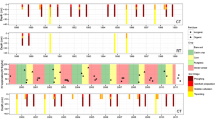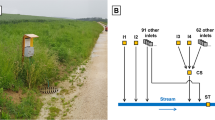Abstract
Subsurface lateral flow in both texture-contrast soils and catchments with shallow bedrock is suspected to be a non-point source of contamination of watercourses by pesticides used in agriculture. As a case study, the north of the Beaujolais region (eastern France) provides a favorable environment for such contamination due to its agro-pedo-climatic conditions. Environments seen in the Beaujolais region include intense viticulture, permeable and shallow soils, steep hillslopes, and storms that occur during the periods of pesticide application. Watercourse contamination by pesticides has been widely observed in this region, and offsite pesticide transport by subsurface lateral flow is suspected to be involved in diffuse and chronic presence of pesticides in surface water. In order to confirm and quantify the potential role of such processes in pesticide transfer, an automated trench system has been designed. The trench was set up on a steep farmed hillslope in a texture-contrast soil. It was equipped with a tipping bucket flow meter and an automatic sampler to monitor pesticide concentrations in lateral flow at fine resolution, by means of a flow-dependent sampling strategy. Four pesticides currently used in vine growing were studied to provide a range of mobility properties: one insecticide (chlorpyrifos-methyl) and three fungicides (spiroxamine, tebuconazole, and dimethomorph). With this system, it was possible to study pesticide concentration dynamics in the subsurface lateral flow, generated by substantial rainfall events following pesticide applications. The experimental design ascertained to be a suitable method in which to monitor subsurface lateral flow and related transfer of pesticides.





Similar content being viewed by others
References
Anderson MG, Burt TP (1977) Automatic monitoring of soil-moisture conditions in a hillslope spur and hollow. J Hydrol 33:27–36. doi:10.1016/0022-1694(77)90096-8
Ankeny MD, Ahmed M, Kaspar TC, Horton R (1991) Simple field method for determining unsaturated hydraulic conductivity. Soil Sci Soc Am J 55:467–470
Bach M, Huber A, Frede HG (2001) Input pathways and river load of pesticides in Germany—a national scale modeling assessment. Water Sci Technol J Int Assoc Water Pollut Res 43:261–268
Brown CD, van Beinum W (2009) Pesticide transport via sub-surface drains in Europe. Environ Pollut 157:3314–3324. doi:10.1016/j.envpol.2009.06.029
Brown CD, Hodgkinson RA, Rose DA, Syers JK, Wilcockson SJ (1995) Movement of pesticides to surface waters from a heavy clay soil. Pestic Sci 43:131–140. doi:10.1002/ps.2780430206
Dabrowski JM, Peall SKC, Reinecke AJ, Liess M, Schulz R (2002) Runoff-related pesticide input into the Lourens River, South Africa: basic data for exposure assessment and risk mitigation at the catchment scale. Water Air Soil Pollut 135:265–283. doi:10.1023/A:1014705931212
Hardie MA, Doyle RB, Cotching WE, Lisson S (2012) Subsurface lateral flow in texture-contrast (duplex) soils and catchments with shallow bedrock. Appl Environ Soil Sci 2012:10. doi:10.1155/2012/861358
Ineris (2012) SIRIS-Pesticides, base de données substances actives 2012. http://www.ineris.fr/siris-pesticides/bdd_siris_pesticides. Accessed 23 January 2015 (in French)
Johnson AC, Haria AH, Bhardwaj CL, Williams RJ, Walker A (1996) Preferential flow pathways and their capacity to transport isoproturon in a structured clay soil. Pestic Sci 48:225–237
Kahl G, Ingwersen J, Nutniyom P, Totrakool S, Pansombat K, Thavornyutikarn P, Streck T (2007) Micro-trench experiments on interflow and lateral pesticide transport in a sloped soil in northern Thailand. J Environ Qual 36:1205–1216. doi:10.2134/jeq2006.0241
Lehman OR, Ahuja LR (1985) Interflow of water and tracer chemical on sloping field plots with exposed seepage faces. J Hydrol 76:307–317. doi:10.1016/0022-1694(85)90139-8
Louchart X, Voltz M, Andrieux P, Moussa R (2001) Herbicide transport to surface waters at field and watershed scales in a Mediterranean vineyard area. J Environ Qual 30:982–991
Margoum C, Guillemain C, Biaudet H, Lepot B (2011) Stabilité des substances organiques dans les échantillons d’eau entre le prélèvement et la prise en charge analytique. Etat de l’art et exemples d’études. Cemagref, Ineris (in French)
McCord JT, Stephens DB (1987) Lateral moisture flow beneath a sandy hillslope without an apparent impeding layer. Hydrol Process 1:225–238. doi:10.1002/hyp.3360010302
Phillips JD (2004) Geogenesis, pedogenesis, and multiple causality in the formation of texture-contrast soils. Catena 58:275–295. doi:10.1016/j.catena.2004.04.002
Rabiet M, Margoum C, Gouy V, Carluer N, Coquery M (2010) Assessing pesticide concentrations and fluxes in the stream of a small vineyard catchment—effect of sampling frequency. Environ Pollut 158:737–748. doi:10.1016/j.envpol.2009.10.014
Reynolds WD, Elrick DE (1991) Determination of hydraulic conductivity using a tension infiltrometer. Soil Sci Soc Am J 55:633–639
Ritsema CJ, Oostindie K, Stolte J (1996) Evaluation of vertical and lateral flow through agricultural loessial hillslopes using a two-dimensional computer simulation model. Hydrol Process 10:1091–1105. doi:10.1002/(sici)1099-1085(199608)10:8<1091::aid-hyp414>3.0.co;2-j
Schafer RB, Caquet T, Siimes K, Mueller R, Lagadic L, Liess M (2007) Effects of pesticides on community structure and ecosystem functions in agricultural streams of three biogeographical regions in Europe. Sci Total Environ 382:272–285. doi:10.1016/j.scitotenv.2007.04.040
Schulz R (2004) Field studies on exposure, effects, and risk mitigation of aquatic nonpoint-source insecticide pollution: a review. J Environ Qual 33:419–448
Smith KA, Mullins CE (1991) Soil analysis: physical methods. Marcel Dekker, New York
SOeS (Service français d’Observation et des Statistiques) (2011) Bilan de présence des micropolluants dans les milieux aquatiques continentaux, Période 2007–2009. In Études & documents du Commissariat général du développement durable, Service de l’observation et des statistiques : n° 54 Octobre 2011. ISBN : 978-2-11-099419-6. www.statistiques.developpement-durable.gouv.fr, 60 p. Accessed 23 Jan 2015 (in French)
Tang X, Zhu B, Katou H (2012) A review of rapid transport of pesticides from sloping farmland to surface waters: processes and mitigation strategies. J Environ Sci 24:351–361
Tlili A, Montuelle B, Berard A, Bouchez A (2011) Impact of chronic and acute pesticide exposures on periphyton communities. Sci Total Environ 409:2102–2113. doi:10.1016/j.scitotenv.2011.01.056
Truman CC, Leonard RA, Johnson AW (1998) Fenamiphos transport, transformation, and degradation in a highly weathered soil. Trans ASAE 41:663–671
Wallach R, Shabtai R (1992) Modeling surface runoff contamination by soil chemicals under transient water infiltration. J Hydrol 132:263–281. doi:10.1016/0022-1694(92)90182-U
Webster R (1966) The measurement of soil water tension in the field. New Phytol 65:249–258. doi:10.1111/j.1469-8137.1966.tb06357.x
Weyman DR (1973) Measurements of the downslope flow of water in a soil. J Hydrol 20:267–288
Whipkey RZ (1965) Subsurface stormflow from forested slopes. Int Assoc Sci Hydrol 10:74–85. doi:10.1080/02626666509493392
Acknowledgments
The financial support of the Water Agency Rhône Méditerranée & Corse is acknowledged. The authors thank M. Letey and C. Dutremble for their contribution to the field work; P. Bouland, vinegrower, for allowing our research on his farmed plot; and the staff of the “diffuse agricultural pollution” team for their help during the digging of the trench.
Conflict of interest
The authors declare that they have no competing interests.
Author information
Authors and Affiliations
Corresponding author
Additional information
Responsible editor: Philippe Garrigues
Rights and permissions
About this article
Cite this article
Peyrard, X., Liger, L., Guillemain, C. et al. A trench study to assess transfer of pesticides in subsurface lateral flow for a soil with contrasting texture on a sloping vineyard in Beaujolais. Environ Sci Pollut Res 23, 14–22 (2016). https://doi.org/10.1007/s11356-015-4917-5
Received:
Accepted:
Published:
Issue Date:
DOI: https://doi.org/10.1007/s11356-015-4917-5




